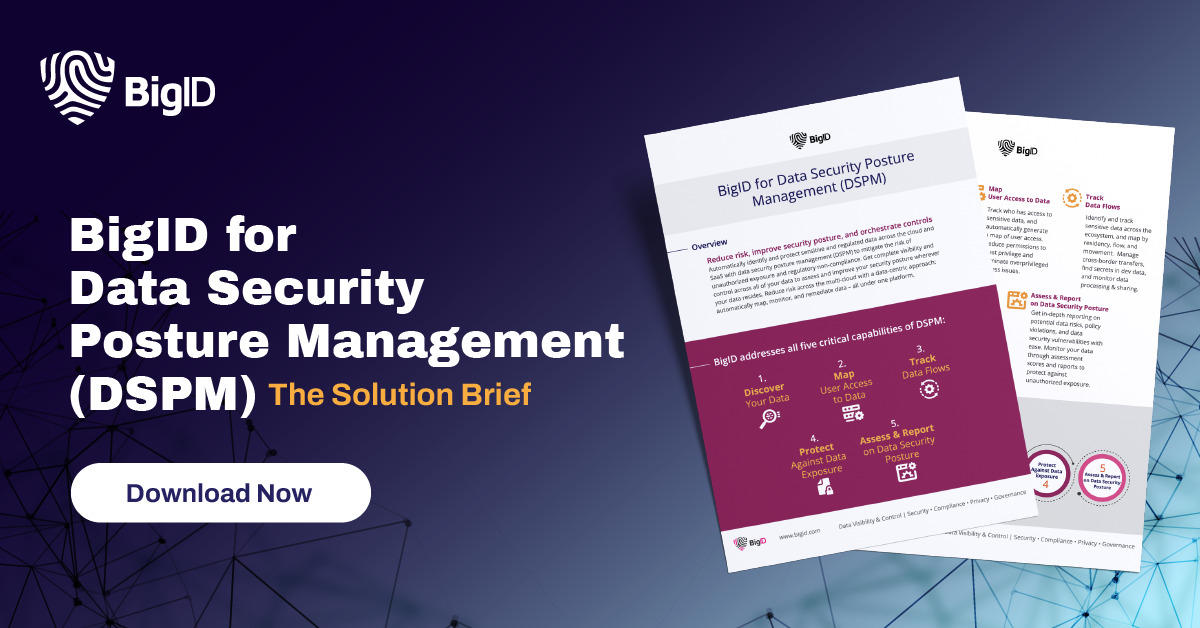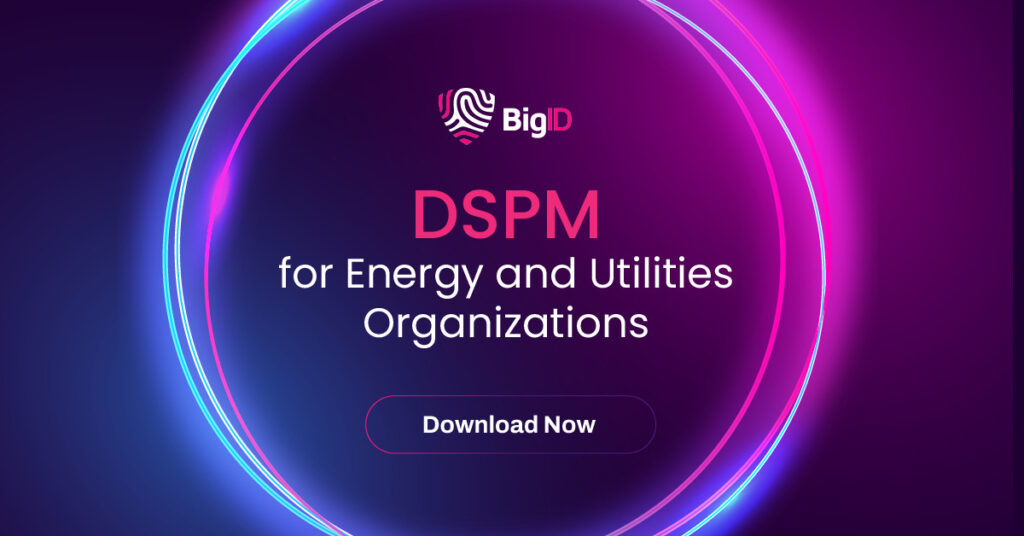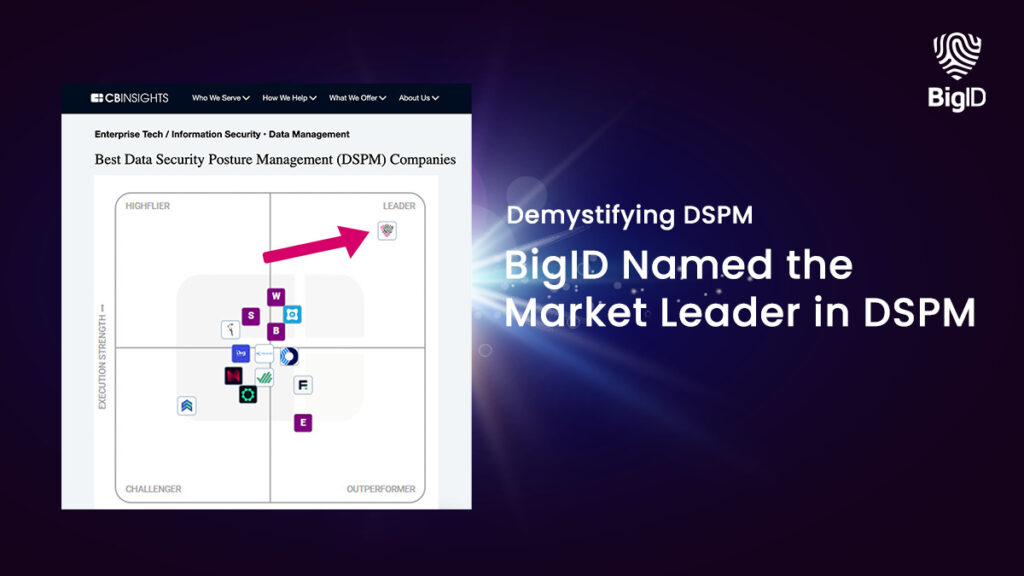Like so many of today’s pressing problems— the best way to solve them is by preventing them from ever happening in the first place. Data is the essence of nearly every organization, and securing it should be a top priority no matter what industry. Take a look at some of the must-have features any Data Security Posture Management (DSPM) solution must have and why BigID’s stands out above the rest as the most reliable and intuitive solution for data protection at scale.
What is DSPM?
Data Security Posture Management— often abbreviated as DSPM— is an advanced security approach designed to help organizations manage and enhance their data security posture across diverse cloud environments. It goes beyond traditional data security measures, offering a comprehensive strategy that encompasses discovery, classification, monitoring, remediation of sensitive data, preventing unauthorized access, and ensuring compliance with data protection regulations.
DSPM aims to provide organizations with a holistic view of their data security landscape, enabling them to identify vulnerabilities, mitigate risks, and respond effectively to potential threats. This groundbreaking approach encompasses “Discovery Plus,” a fusion of data discovery and security management capabilities. Coined by Gartner in April 2022, DSPM addresses the critical need for organizations of all sizes to proactively manage data security risks across their complex and dynamic environments.
At the core of DSPM tools lies the concept of risk management. Security and risk management leaders face the challenge of identifying, understanding, and remediating data security risks effectively. With data becoming increasingly valuable and vulnerable, it’s essential to have a robust strategy to assess and mitigate these risks.
How DSPM Works
Data security posture management operates through a variation of automated tools, intelligent algorithms, and data monitoring capabilities. It continuously scans and assesses the data landscape, evaluating security configurations, access controls, and potential risks. This combined analysis of data movement, access patterns, and user behavior— provide valuable insight into how security teams can strengthen their organization’s overall security posture.
This form of posture management functions as a dynamic shield for your organization’s data assets, leveraging a powerful synergy of automated tools, intelligent algorithms, and advanced data monitoring capabilities. At its core, DSPM acts as a vigilant sentry, tirelessly scanning and assessing your data infrastructure with unwavering precision. It conducts thorough evaluations of security configurations, access controls, and potential risks, leaving no stone unturned in its pursuit of data protection.
DSPM solutions initiate a comprehensive discovery and classification phase, meticulously identifying and mapping all data sources within your organizational framework. Leveraging advanced machine learning algorithms, DSPM tools digs deeper— intricately classifying data to offer a nuanced comprehension of its sensitivity and significance.
When it comes to monitoring and remediation aspects, DSPM solutions ensure continuous oversight, providing real-time visibility into data usage, movement, and potential risks. Should anomalies or policy violations be flagged, DSPM promptly triggers automated remediation processes— proactively averting data breaches and upholding stringent compliance standards. It’s a holistic strategy that not only discovers and understands your data landscape but actively monitors and addresses potential threats in real-time.

Key Components
- Data Mapping: BigID’s DSPM adopts a meticulous approach to data mapping, creating an exhaustive overview of your data landscape. This includes a thorough exploration of structured and unstructured data, covering cloud-based repositories and on-premises databases to leave no corner unexplored.
- Identity Correlation: DSPM takes data security a step further by correlating data with user identities, offering a detailed insight into who accesses sensitive information. This granular understanding empowers organizations to enforce stringent access controls tailored to specific user roles, thereby enhancing overall security measures.
- Real-time Monitoring: The solution doesn’t stop at mapping and correlation; it extends into real-time monitoring of data activity. By providing immediate alerts for any suspicious behavior or policy violations, DSPM ensures a proactive stance against potential threats. This continuous vigilance is a key element in maintaining a secure data environment.
Why You Need Data Security Posture Management
DSPM solutions are one of the few saving graces in an age where data breaches can have devastating consequences for organizations and individuals alike. As data continues to increase— and the recognized value along with it— cybercriminals will continuously devise sophisticated methods to exploit vulnerabilities. DSPM offers several key benefits that make it an irreplaceable part of a robust cybersecurity strategy:
- Comprehensive Protection: DSPM provides a unified approach to data security, enabling organizations to identify and address vulnerabilities across their data landscape, regardless of where the data resides.
- Regulatory Compliance: With stringent data protection regulations like GDPR and CCPA in place, DSPM assists organizations in achieving and maintaining compliance, avoiding costly fines and reputational damage.
- Risk Mitigation: By proactively identifying and addressing security risks, DSPM helps mitigate potential breaches and data leaks, safeguarding an organization’s sensitive information.
- Operational Efficiency: Centralizing data security functions through DSPM streamlines processes, reducing complexity and improving overall operational efficiency.
With the constantly evolving landscape of cyber threats and stringent data privacy regulations, relying on traditional security measures is no longer sufficient. DSPM tools are a necessity for today’s organizations.
Where Does DSPM Fit Into the Modern Data Security Environment
Data Security Posture Management doesn’t operate in isolation but, rather, harmonizes with the existing security measures, seamlessly integrating into the broader security ecosystem. Picture your data security environment as a complex tapestry interwoven with various threads of protection mechanisms and protocols. In this intricate fabric, DSPM acts as a central thread, weaving through the layers and enhancing the overall resilience of the system.
Its adaptive nature allows it to complement and augment the capabilities of conventional security tools. This integration is pivotal, considering the multifaceted nature of modern cybersecurity challenges.
Whether it’s the intricacies of regulatory compliance, the intricacies of cloud-based environments, or the challenges posed by emerging technologies, DSPM solutions positions itself at the forefront. It acts as a strategic player, not just responding to threats but actively shaping and fortifying your organization’s data security strategy.
How DSPM Fits Into Your Security Strategy
- Integration with Existing Security Infrastructure: DSPM tools seamlessly integrate with your current suite of security tools, elevating their functionalities and fostering a cohesive and comprehensive security environment.
- Collaboration with Identity and Access Management (IAM): Through the correlation of data with user identities, DSPM actively collaborates with Identity and Access Management (IAM) solutions. This collaboration empowers organizations to enforce precise access controls, thereby fortifying overall security measures.
- Alignment with Zero Trust Frameworks: DSPM solutions align seamlessly with the principles of Zero Trust, embodying a continuous verification approach for users and devices interacting with sensitive data. This alignment ensures a proactive and vigilant security stance in line with contemporary cybersecurity paradigms.

Benefits of DSPM Tools
Data Security Posture Management tools are a crucial solution in today’s digital landscape, offering a host of invaluable benefits to organizations of all sizes— like enhanced data protection, ensuring the confidentiality, integrity, and availability of critical information.
Data Discovery and Classification
Implementing deep data discovery and classification, access controls, and real-time monitoring, DSPM tools mitigate the risk of data breaches and unauthorized access, giving business some very much needed peace of mind. This coupled with proactive risk management capabilities, continuous monitoring and analysis, DSPM solutions enable organizations to identify potential vulnerabilities and security gaps, empowering them to take proactive measures before threats occur.
Compliance
When it comes to compliance— DSPM tools really take a shine by helping businesses navigate the complexities of data security regulations and avoiding potential penalties and reputational damage. In addition to streamlining operations and reducing costs by automating security processes, freeing up valuable resources for strategic initiatives.
DSPM tools are a data-centric form of security, focusing on protecting the data itself rather than just the perimeter. This approach acknowledges that data is the most critical asset and ensures its protection across different cloud platforms and applications.
Adopting a data-centric security strategy allows organizations to shift their focus from building stronger and more fortified outer defenses to implementing robust controls and secure access protocols for data. This ensures that only authorized individuals can access sensitive information, mitigating the risk of data breaches and unauthorized disclosure.
How to Get Started with DSPM
Embarking on the DSPM journey is a strategic decision that requires careful planning. Here’s a step-by-step guide to kickstart your DSPM implementation:
- Assess Your Data Landscape: Conduct a comprehensive assessment of your organization’s data landscape, identifying data sources, and understanding data flow. Dive deep into the intricacies of your data ecosystem to gain insights into the types of data you handle, their sensitivity, and the existing security measures.
- Choose the Right DSPM Solution: Select a DSPM solution that aligns with your organization’s size, industry, and specific security requirements. Evaluate potential solutions based on their scalability, compatibility with existing security infrastructure, and the level of customization they offer.
- Develop a Deployment Plan: Create a deployment plan that outlines the phased implementation of DSPM, considering potential challenges and resource availability. Define clear milestones and timelines for each phase, ensuring a smooth and controlled rollout of DSPM across different departments or business units.
- Establish Data Classification Policies: Define robust data classification policies to categorize information based on sensitivity, ensuring that the DSPM solution can effectively identify and protect critical data. Work closely with stakeholders to align data classification policies with business objectives and compliance requirements.
- Implement Access Controls: Integrate access controls within the DSPM solution, ensuring that only authorized personnel have the privilege to interact with sensitive data. Fine-tune access policies based on user roles, creating a secure and streamlined environment for data handling.
- Provide Training and Awareness: Conduct training sessions to familiarize employees with the DSPM solution, emphasizing its significance in safeguarding data. Foster a culture of awareness regarding data security, encouraging proactive engagement from all members of the organization.
- Monitor and Optimize: Establish continuous monitoring mechanisms to track the performance of DSPM in real-time. Regularly evaluate the effectiveness of the implemented solution, making necessary adjustments to optimize its performance and address emerging security challenges.
DSPM Best Practices
Effective configuration and planning are integral to successful Data Security Posture Management (DSPM), encompassing both ongoing tuning and the development of robust policy frameworks and procedures. As you embark on the adoption and deployment of a DSPM solution, consider these five fundamental best practices to fortify your data security measures.
- Discover and Classify Data: Attaining visibility and control over sensitive data within your ecosystem is paramount to diminishing overall data breach risk. Utilize data tagging or similar solutions to classify both structured (e.g., PII) and unstructured data (e.g., source code, secrets, intellectual property). This classification approach empowers your security team to pinpoint critical areas requiring heightened security measures.
- Restrict Data Access and Implement Least-Privileged Access: Managing access to data stands as a foundational element of cybersecurity hygiene. Effective cloud data security mandates the administration of privileged access while simultaneously curbing data breach exposure, reducing friction for privileged users, upholding customer trust, and ensuring compliance.
- Perform Continuous Risk Assessment and Compliance Auditing: As data dynamically traverses the cloud, it necessitates continuous monitoring of new and modified data stores vis-à-vis your security posture and regulatory requirements. This involves regular assessments, audits, and scrutiny of network traffic, system logs, and user activity. Given the diverse mandates governing sensitive data (e.g., GDPR, CCPA, HIPAA, PCI DSS), a comprehensive approach beyond mere classification is imperative to guarantee compliance.
- Prioritize Risk and Remediation: The ability to analyze and score data risks based on factors such as data sensitivity, regulatory compliance, security controls, and more is crucial for prioritizing security efforts and implementing proactive remediation measures. Configuring real-time alerts and notifications based on this analysis enables swift and effective responses to potential incidents, minimizing the impact of a breach.
- Establish Security Policies and Procedures: Governance over how data is handled and protected demands the implementation of appropriate policies and procedures. These should encompass data access, use, storage, and disposal, aligning with industry standards and regulatory mandates. By instituting clear policies and procedures, the likelihood of human error or intentional data misuse leading to a breach is significantly reduced.

What Can a DSPM Solution Provide
A robust DSPM solution, such as BigID’s, provides a spectrum of features and capabilities:
Find, Classify, and Map Sensitive Data Across Your Environment: Automatically discover, tag, and inventory unstructured and structured data. Covers both on-premises and cloud environments in a single view.
- Discover Dark Data, Shadow Data, and Unknown Data: Uncover known and unknown data, including hidden cloud data. Identify duplicate, similar, redundant, obsolete, and trivial (ROT) data. Detects sensitive and critical data like regulated data, secrets, intellectual property, and business data.
- Identify Potential Access & Exposure Risks: Understand data access permissions for different users. Monitor data sharing both internally and externally. Utilize access intelligence to reduce insider risks, accelerate zero trust, and achieve least privilege.
- Alert on High-Risk Vulnerabilities and Critical Issues: Automatically trigger alerts based on risk levels and policy violations. Detect insider risks and accelerate investigation processes. Enable security teams to investigate, resolve, and track security alerts efficiently.
- Easily Report and Assess Risk: Conduct data risk assessments to understand the risk posture. Provide granular and high-level reporting on crown jewel data regularly. Monitor progress and improvements in risk posture over time.
- Actionable Insight: Offer guidance on remediating identified risks. Automate, guide, and orchestrate remediation for high-risk data. Trigger alerts based on relevant activity without causing unnecessary noise.
- Be Enterprise Ready: Provide enterprise-grade security and scan management. Ensure minimal disruption to business operations. Offer granular Role-Based Access Control (RBAC) and scope down roles. Support iterative scanning and seamless integration with the existing tech stack.
DSPM vs CSPM vs CIEM
DSPM, cloud security posture management (CSPM), and cloud infrastructure entitlement management (CIEM) solutions are integral for overseeing your security posture, each offering distinct advantages:
- DSPM (Data Security Posture Management): Focuses on your overall data security posture across on-premises and cloud environments. Assists in identifying and assessing risks, monitoring controls, and planning incident response.
- CSPM (Cloud Security Posture Management):Concentrates on cloud data security, specifically addressing risk and compliance issues in cloud environments. Achieves this through asset discovery, configuration and access management, and detection and response. Read more on the differences between CSPM vs DSPM.
- CIEM (Cloud Infrastructure Entitlement Management): Monitors, identifies, and manages risks and noncompliance linked to entitlements and permissions in cloud infrastructure.
Each of these three approaches— while unique in their application and scope— can often be used simultaneously with one another to better protect an organization’s attack surface.
BigID’s Ultimate DSPM Solution
In the forefront of the data security posture management evolution stands BigID, a leading innovator in data security and privacy management, as recognized by CB Insights. BigID’s cutting-edge platform empowers organizations to proactively manage and protect their sensitive data. Leveraging advanced machine learning and AI, BigID enables accurate data discovery, classification, and identification, ensuring compliance with regulatory requirements like GDPR and CPRA.
Key capabilities of BigID’s DSPM solution include:
- Automated Discovery and Categorization: Automatically identifies, labels, and organizes both structured and unstructured data across on-premises and cloud environments, all within a unified user interface.
- Risk Identification for Access and Exposure: Provides insights into data access, exposure risks, and instances of data overexposure. Monitors data sharing, both internally and externally, with integrated access intelligence to reduce insider threats and accelerate zero-trust implementation.
- Alerts for High-Risk Vulnerabilities: Autonomously triggers alerts based on risk levels, policy breaches, and potential insider threats. Facilitates a swift investigative process for security teams to explore, resolve, and monitor security alerts and risk mitigation efforts.
- Simplified Reporting and Risk Assessment: Generates comprehensive reports detailing risk posture, progress monitoring, and tracking advancements. Initiates data risk assessments to gauge the organization’s security position, providing both detailed and high-level reports on critical data regularly.
Ready to elevate your data security strategy? Get a 1:1 demo to see how BigID does DSPM differently today.


